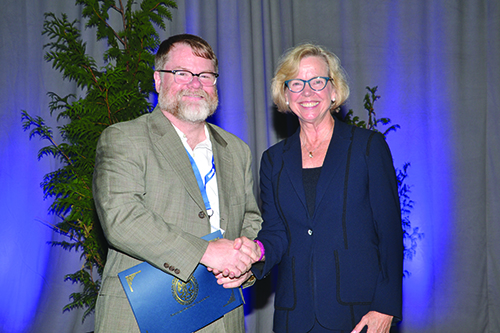Karl E. Peace Award Recognizes Work of Patrick Ball
David Corliss, Ford Motor Company

Patrick Ball accepts the Peace Award from ASA President Lisa LaVange during this year’s awards ceremony during the 2018 Joint Statistical Meetings in Vancouver, Canada.
The American Statistical Association’s 2018 Karl E. Peace Award for Outstanding Statistical Contributions for the Betterment of Society recently recognized the work of leading human rights mathematician Patrick Ball of the Human Rights Data Analysis Group (HRDAG). The award is presented annually to statisticians whose exemplary statistical research is matched by the impact their work has had on the lives of people.
Established by the family of Karl E. Peace in honor of his work for the good of society, the award—announced at the Joint Statistical Meetings—is bestowed upon distinguished individual(s) who have made substantial contributions to the statistical profession, contributions that have led in direct ways to improving the human condition. Recipients will have demonstrated through their accomplishments their commitment to service for the greater good.”
This year, Ball became the 10th recipient of the award.
Ball is the co-founder and first executive director of the Human Rights Data Analysis Group (HRDAG), an independent NGO (nongovernmental organization) investigating human rights violations around the world and providing partners with sound, data-driven evidence for seeking justice. Elected a fellow of the American Statistical Association in 2014, he now serves as HRDAG’s director of research, focusing on analytic projects and methodologies.
Ball has dedicated his career to the rigorous statistical analysis of human rights violations, especially by state actors, including war crimes and genocide. His quantitative analysis has supported investigations by the UN and other NGOs, truth commissions, and human rights crime tribunals in more than 15 countries. His testimony as an expert witness played a central role in war crime trials before the International Criminal Tribunal for the former Yugoslavia, in which Serb leader Radovan Karadžić and General Ratko Mladić were found guilty of genocide, crimes against humanity, and other crimes. He also served as an expert witness at the Guatemalan trial of dictator General José Efraín Ríos Montt and others, contributing to the first conviction for genocide of a former head of state in his own country. HRDAG’s important work on human rights abuses in Guatemala continues today.
Ball’s contributions have been multifaceted, combining statistical methods; standards for developing and presenting scientific evidence of rights violations; project and organization management; and mentoring, education, and advocate development. One important scientific advancement has been the application of capture-recapture methodology to human rights. This method has been used by ecologists for more than a century to determine the size of animal populations.
The classic example of capture-recapture is counting the number of fish in a lake. First, fish are caught by some group or researchers by some method, who tag and release all the fish they catch. A subsequent round of fishing may vary by who is doing it or by the method used—this flexibility in methodology being important to human rights applications of capture-recapture. The second team counts both the number of fish caught and the number of tagged fish previously recorded by the first team and method. The number of fish in the lake is equal to the number caught by the first team multiplied by the number from the second team divided by the number caught by both teams—that is, the count of tagged fish caught by the second team.
The application of capture-recapture methodology to human rights violations has been critical to obtaining scientifically accurate victim counts. Ball’s work has been an important contributor in establishing capture-recapture as an investigation tool in a difficult situation often encountered by human rights statisticians: where multiple agencies and organizations provide independent but incomplete reporting of human rights violations and other crimes. Ball and current HRDAG Executive Directory Megan Price reviewed this work in the Winter 2018 issue of CHANCE, including a detailed description of the statistical methodology.
Use of capture-recapture is growing. At JSM, RTI’s Duren Banks presented on using capture-recapture to obtain reliable counts of persons who have died in police custody. Following HRDAG’s research, a new pilot project at Peace-Work is applying capture-recapture to count human trafficking victims in the United States.
Many of those nominating or commending Ball on this award mentioned the importance of his leadership above and beyond his statistical research and practice. Ball’s work in collaboration, presenting, teaching, and mentoring extend his impact beyond the critical work of publishing papers and testifying in court. He maintains and trains the complete picture of a person making an impact on society through statistics. This has provided a path for others to follow in Data for Good (D4G), either as a person’s primary focus or for a career in which it plays an important part-time role.
Data for Good is uplifting, but it can also be a long hard road on which one explores the greatest depths of human fears, loss, and cruelty. Ball, HRDAG, and all who labor in these areas show how the light of D4G shines brightest in the darkest places. For more than 20 years, Ball has been showing how to kindle that light and encourage all of us to carry it forward.

















